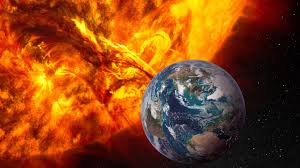After the solar flare, the Solar and Heliospheric Observatory (SOHO) spotted a massive coronal mass ejection (CME) heading straight for Earth, moving faster than 1,000 kilometers per second.
**In Short:**
A series of powerful solar events are set to impact Earth, possibly causing significant geomagnetic storms in the next few days.

Three coronal mass ejections (CMEs) are heading our way: the first two, launched by M-class solar flares on August 7, are minor, but the third, from an X1.3-class solar flare on August 8, is much stronger.
The X1.3-class flare, originating from sunspot AR3777, produced a significant ultraviolet flash that caused a shortwave radio blackout across North America and the Hawaiian Islands for up to an hour. Following this, a fast-moving halo CME was detected heading toward Earth at over 1,000 km per second.
Expected to arrive by August 11, this CME, combined with the earlier CMEs, might trigger a strong geomagnetic storm (category G3), potentially leading to mid-latitude auroras visible in the USA and Europe. Geomagnetic storms can cause beautiful auroras but may also disrupt GPS, radio communications, and power systems.
Sunspot AR3777, responsible for the recent flare, is one of the most active regions on the Sun, signaling increased solar activity as we approach the solar maximum. The National Oceanic and Atmospheric Administration (NOAA) has issued a geomagnetic storm watch, advising those affected by space weather, such as mariners, ham radio operators, and satellite users, to stay informed and take precautions.
Earlier in May, a similar solar storm had caused auroras as far as India and put satellites under pressure.